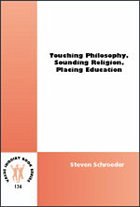This book redefines religious studies as a field in which a plurality of disciplines interact. A social science when understood as a body of knowledge, religion is also marked by discovery, appreciation, orientation, and application-an interplay of the arts and sciences. Teaching religious studies involves the question of the occupation of territories and disentangling occupation from violence.
CONTENTS
FOREWORD by David Belcastro
PREFACE
ACKNOWLEDGMENTS
ONE Carried Away
1. The Temptation of Space
2. Against the Hegemony of Vision
3. Separation
4. The Religious Function of Home
5. Every Map Is A Myth
6. A Masterpiece of Structural Tenacity
7. Spatialization of Place
8. Cultural Systems
9. Three Themes
TWO The Necessity of Theory
1. Observation As Action
2. Objectivity
3. Cognitive Linguistics
4. Phenomenological Geography
5. Ecological Psychology
6. The Body Is An Act
THREE The Displacement of Society
1. Home and Exile
2. The Power To See
3. A History of Powers
4. Perception
5. Getting Ourselves Together
FOUR A Moral Dimension of Place
1. Loaded Symbols
2. Making An Impression
3. Aesthetics and Ethics
4. Tapestries Woven of Power
FIVE The Body Politic
1. Constructing Coherence
2. Culture
3. Intelligence
4. Perception, Again
5. Play, Possibility, and Power
SIX Perceiving God Perceiving
1. Perception, Finally
2. A Twisted Universe
3. Philosophical Correspondences
4. Education and Distance
SEVEN A Laboratory for Civil Discourse
1. Experiment
2. City Speech
3. The Classroom As City
REFERENCES
ABOUT THE AUTHOR
INDEX
CONTENTS
FOREWORD by David Belcastro
PREFACE
ACKNOWLEDGMENTS
ONE Carried Away
1. The Temptation of Space
2. Against the Hegemony of Vision
3. Separation
4. The Religious Function of Home
5. Every Map Is A Myth
6. A Masterpiece of Structural Tenacity
7. Spatialization of Place
8. Cultural Systems
9. Three Themes
TWO The Necessity of Theory
1. Observation As Action
2. Objectivity
3. Cognitive Linguistics
4. Phenomenological Geography
5. Ecological Psychology
6. The Body Is An Act
THREE The Displacement of Society
1. Home and Exile
2. The Power To See
3. A History of Powers
4. Perception
5. Getting Ourselves Together
FOUR A Moral Dimension of Place
1. Loaded Symbols
2. Making An Impression
3. Aesthetics and Ethics
4. Tapestries Woven of Power
FIVE The Body Politic
1. Constructing Coherence
2. Culture
3. Intelligence
4. Perception, Again
5. Play, Possibility, and Power
SIX Perceiving God Perceiving
1. Perception, Finally
2. A Twisted Universe
3. Philosophical Correspondences
4. Education and Distance
SEVEN A Laboratory for Civil Discourse
1. Experiment
2. City Speech
3. The Classroom As City
REFERENCES
ABOUT THE AUTHOR
INDEX

